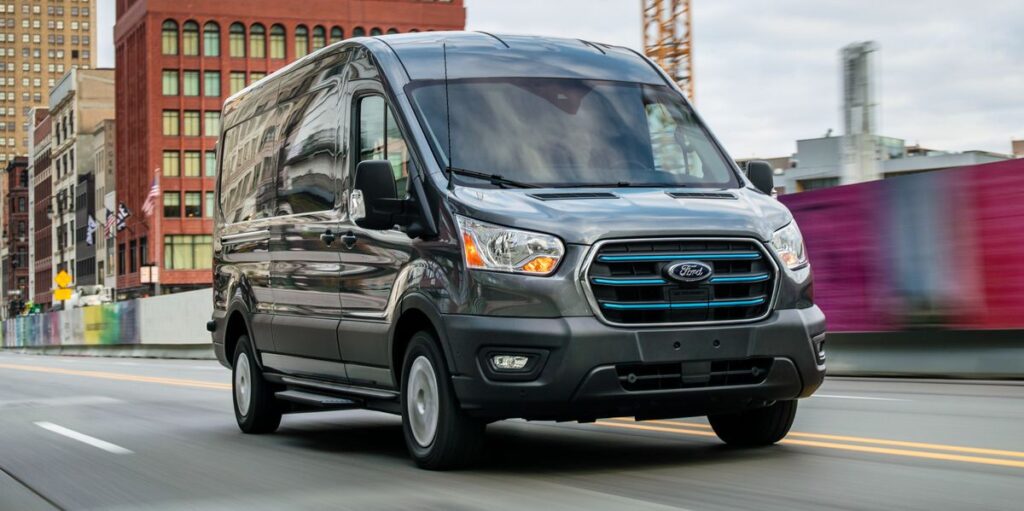2023 Ford E-Transit

Overview
The cargo-van-only E-Transit is visually almost indistinguishable from the gas-powered Transit, but it’s geared towards a different customer base: those who want a zero-emissions electric hauler who don’t need much driving range. While the #Vanlife Transit Trail equivalent isn’t offered, the E-Transit is available in chassis-cab, cutaway, and cargo-van configurations, allowing it to be tailored to the varying needs of commercial customers. Buyers will also have to decide between three different roof heights and three different wheelbase lengths. Standard equipment includes Ford’s Sync 4 infotainment system, various driver-assistance safety tech like lane-keep assist and automatic braking, 4G connectivity, and vinyl bucket front seats with manual four-way adjustability. Those looking to add a battery-powered full-size van to their fleet have but one vehicle to choose from: this one. It has an estimated range of 126 miles, and a DC fast charger can replenish the battery enough to provide 30 miles of range in only 10 minutes. The E-Transit’s range may not seem like a lot but Ford believes that, for the targeted clientele—tradesman and delivery drivers—the range should be adequate. The sales figures will reveal if customers agree.
What’s New for 2023?
The 2023 Ford E-Transit gets minor updates, including two newly available school bus packages and two new exterior color options: Blue Metallic and Blue Mist. Back-up alarm options are also now available, including a white noise option, and fixed shelving is now offered for high-roof models. Ford has also made a reverse speed limiter standard for all E-Transit models.
Pricing and Which One to Buy
Cutaway
$51,370
Chassis Cab
$51,900
$55,585
The cheapest version of the E-Transit is the Cutaway style which lacks a rear cargo area and is offered to custom upfitters. The better way to go for most consumers will be the cargo-van body style.
EV Motor, Power, and Performance
A single electric motor pumps out 266 horsepower and 317 pound-feet of torque; the E-Transit employs a rear-wheel-drive setup; all-wheel drive is not available. Straight-line performance is of little importance to commercial buyers, and Ford hasn’t released any 60-mph time estimates but we expect the E-Transit to offer perky acceleration, at least when unladen. The company does say that the E-Transit’s suspension system has been revised from the gasoline-powered Transit’s to improve handling. When we get a chance to test-drive the E-Transit, we’ll report our driving impressions here.
More on the E-Transit Van
Towing and Payload Capacity
A towing capacity for the E-Transit is unknown for now, but the maximum payload for the cargo van is 3880 pounds ranging up to 4513 pounds for the cutaway model.
Range, Charging, and Battery Life
The E-Transit’s battery pack is a 67.0-kWh unit that’s good for up to 126 miles of driving per charge, Ford says. The pack can be recharged using either AC power outlets or via a DC fast charging station. Ford will provide a mobile charger that can be used to charge the E-Transit at home and will also offer a more powerful charging station that can be installed in a buyer’s garage. Otherwise, drivers can re-juice at public charging stations.
Fuel Economy and Real-World MPGe
The EPA hasn’t released any estimates for the E-Transit’s fuel economy. When we get the chance to test the E-Transit for ourselves, we’ll subject it to our 75-mph highway fuel economy test and update this story with MPGe and driving-range results. For more information about the E-Transit’s fuel economy, visit the EPA’s website.
Interior, Comfort, and Cargo
The E-Transit will be offered solely with seats for just two. As a workhorse, the E-Transit’s cabin is utilitarian, with rubberized flooring, durable plastic trim, and cloth seat upholstery. Both standard-height and high-roof models are offered, as well as normal and extended-wheelbase bodies. Cargo space will be plentiful no matter which body style is chosen; the biggest extended-wheelbase model with the high roof offers more than 487 cubic feet of cargo room.
The Car and Driver Difference
Infotainment and Connectivity
All models of the E-Transit will come standard with a 12.0-inch infotainment system which dwarfs the 4.0-inch display in the regular Transit. It’s even larger and more sophisticated than the regular Transit’s optional 8.0-inch display as it runs Ford’s latest Sync 4 operating system. An onboard 4G LTE modem provides a Wi-Fi hotspot and also connectivity features for fleet managers, including vehicle telematics. The infotainment system is capable of receiving over-the-air updates.
How to Buy and Maintain a Car
Safety and Driver-Assistance Features
The E-Transit comes standard with a suite of driver-assistance features called Co-Pilot360 with more advanced driver-aids available as options. For more information about the E-Transit’s crash-test results, visit the National Highway Traffic Safety Administration (NHTSA) and Insurance Institute for Highway Safety (IIHS) websites. Key safety features include:
Standard automated emergency braking Standard lane-departure warning with lane-keeping assist Available adaptive cruise control with traffic sign recognition
Warranty and Maintenance Coverage
Ford’s standard warranty package is fairly basic and falls in line with the industry norm. The E-Transit offers an eight-year/100,000 mile warranty on its battery components, but Ford doesn’t offer any complimentary scheduled maintenance plans.
Limited warranty covers three years or 36,000 miles Powertrain warranty covers five years or 60,000 miles Battery components warranty covers eight years or 100,000 miles No complimentary scheduled maintenance
More Features and Specs




